Danish vs Lumbee Community Comparison
COMPARE
Danish
Lumbee
Social Comparison
Social Comparison
Danes
Lumbee
8,781
SOCIAL INDEX
85.3/ 100
SOCIAL RATING
48th/ 347
SOCIAL RANK
2,002
SOCIAL INDEX
17.6/ 100
SOCIAL RATING
276th/ 347
SOCIAL RANK
Lumbee Integration in Danish Communities
The statistical analysis conducted on geographies consisting of 86,813,919 people shows a poor positive correlation between the proportion of Lumbee within Danish communities in the United States with a correlation coefficient (R) of 0.135. On average, for every 1% (one percent) increase in Danes within a typical geography, there is an increase of 0.236% in Lumbee. To illustrate, in a geography comprising of 100,000 individuals, a rise of 1,000 Danes corresponds to an increase of 236.5 Lumbee.
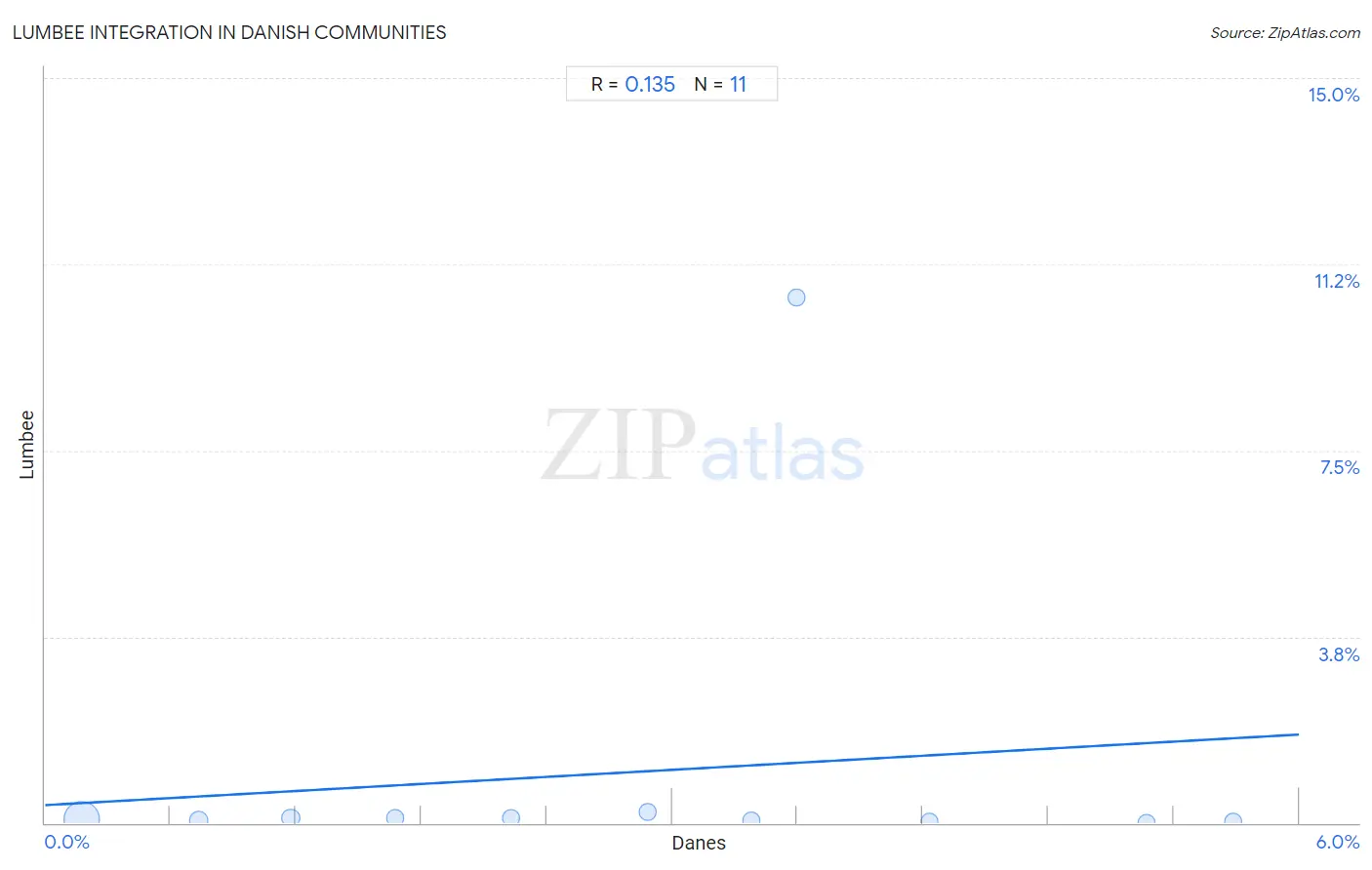
Danish vs Lumbee Income
When considering income, the most significant differences between Danish and Lumbee communities in the United States are seen in householder income ages 45 - 64 years ($105,619 compared to $65,113, a difference of 62.2%), householder income ages 25 - 44 years ($97,221 compared to $60,305, a difference of 61.2%), and median household income ($87,676 compared to $54,644, a difference of 60.5%). Conversely, both communities are more comparable in terms of median female earnings ($37,730 compared to $32,500, a difference of 16.1%), median earnings ($46,392 compared to $36,876, a difference of 25.8%), and median male earnings ($56,246 compared to $41,715, a difference of 34.8%).

| Income Metric | Danish | Lumbee |
| Per Capita Income | Good $44,095 | Tragic $29,845 |
| Median Family Income | Excellent $105,900 | Tragic $68,679 |
| Median Household Income | Excellent $87,676 | Tragic $54,644 |
| Median Earnings | Average $46,392 | Tragic $36,876 |
| Median Male Earnings | Excellent $56,246 | Tragic $41,715 |
| Median Female Earnings | Tragic $37,730 | Tragic $32,500 |
| Householder Age | Under 25 years | Excellent $53,041 | Tragic $34,584 |
| Householder Age | 25 - 44 years | Excellent $97,221 | Tragic $60,305 |
| Householder Age | 45 - 64 years | Exceptional $105,619 | Tragic $65,113 |
| Householder Age | Over 65 years | Exceptional $63,117 | Tragic $40,550 |
| Wage/Income Gap | Tragic 31.0% | Exceptional 21.3% |
Danish vs Lumbee Poverty
When considering poverty, the most significant differences between Danish and Lumbee communities in the United States are seen in receiving food stamps (9.0% compared to 22.9%, a difference of 153.6%), child poverty among boys under 16 (13.6% compared to 31.9%, a difference of 134.4%), and family poverty (7.3% compared to 17.0%, a difference of 132.8%). Conversely, both communities are more comparable in terms of single mother poverty (28.5% compared to 43.2%, a difference of 51.7%), female poverty among 18-24 year olds (19.8% compared to 31.1%, a difference of 56.7%), and single female poverty (20.7% compared to 33.0%, a difference of 59.6%).
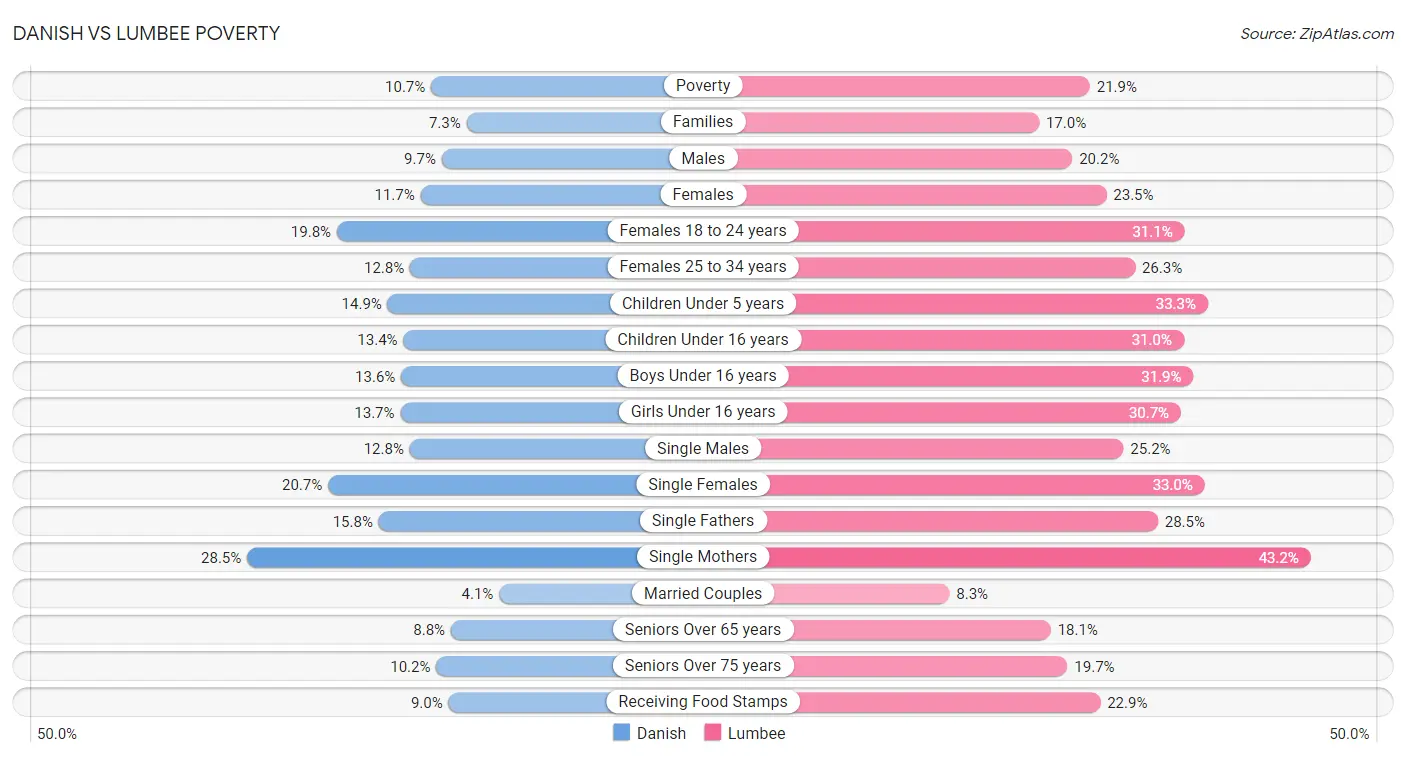
| Poverty Metric | Danish | Lumbee |
| Poverty | Exceptional 10.7% | Tragic 21.9% |
| Families | Exceptional 7.3% | Tragic 17.0% |
| Males | Exceptional 9.7% | Tragic 20.2% |
| Females | Exceptional 11.7% | Tragic 23.5% |
| Females 18 to 24 years | Good 19.8% | Tragic 31.1% |
| Females 25 to 34 years | Exceptional 12.8% | Tragic 26.3% |
| Children Under 5 years | Exceptional 14.9% | Tragic 33.3% |
| Children Under 16 years | Exceptional 13.4% | Tragic 31.0% |
| Boys Under 16 years | Exceptional 13.6% | Tragic 31.9% |
| Girls Under 16 years | Exceptional 13.7% | Tragic 30.7% |
| Single Males | Average 12.8% | Tragic 25.2% |
| Single Females | Good 20.7% | Tragic 33.0% |
| Single Fathers | Exceptional 15.8% | Tragic 28.5% |
| Single Mothers | Excellent 28.5% | Tragic 43.2% |
| Married Couples | Exceptional 4.1% | Tragic 8.3% |
| Seniors Over 65 years | Exceptional 8.8% | Tragic 18.1% |
| Seniors Over 75 years | Exceptional 10.2% | Tragic 19.7% |
| Receiving Food Stamps | Exceptional 9.0% | Tragic 22.9% |
Danish vs Lumbee Unemployment
When considering unemployment, the most significant differences between Danish and Lumbee communities in the United States are seen in unemployment among women with children under 6 years (7.1% compared to 13.8%, a difference of 93.1%), unemployment among ages 25 to 29 years (6.0% compared to 11.2%, a difference of 86.0%), and unemployment among women with children under 18 years (4.5% compared to 7.1%, a difference of 55.9%). Conversely, both communities are more comparable in terms of unemployment among ages 60 to 64 years (4.4% compared to 4.2%, a difference of 4.7%), unemployment among seniors over 65 years (4.9% compared to 4.6%, a difference of 5.5%), and unemployment among ages 65 to 74 years (5.2% compared to 4.8%, a difference of 9.3%).
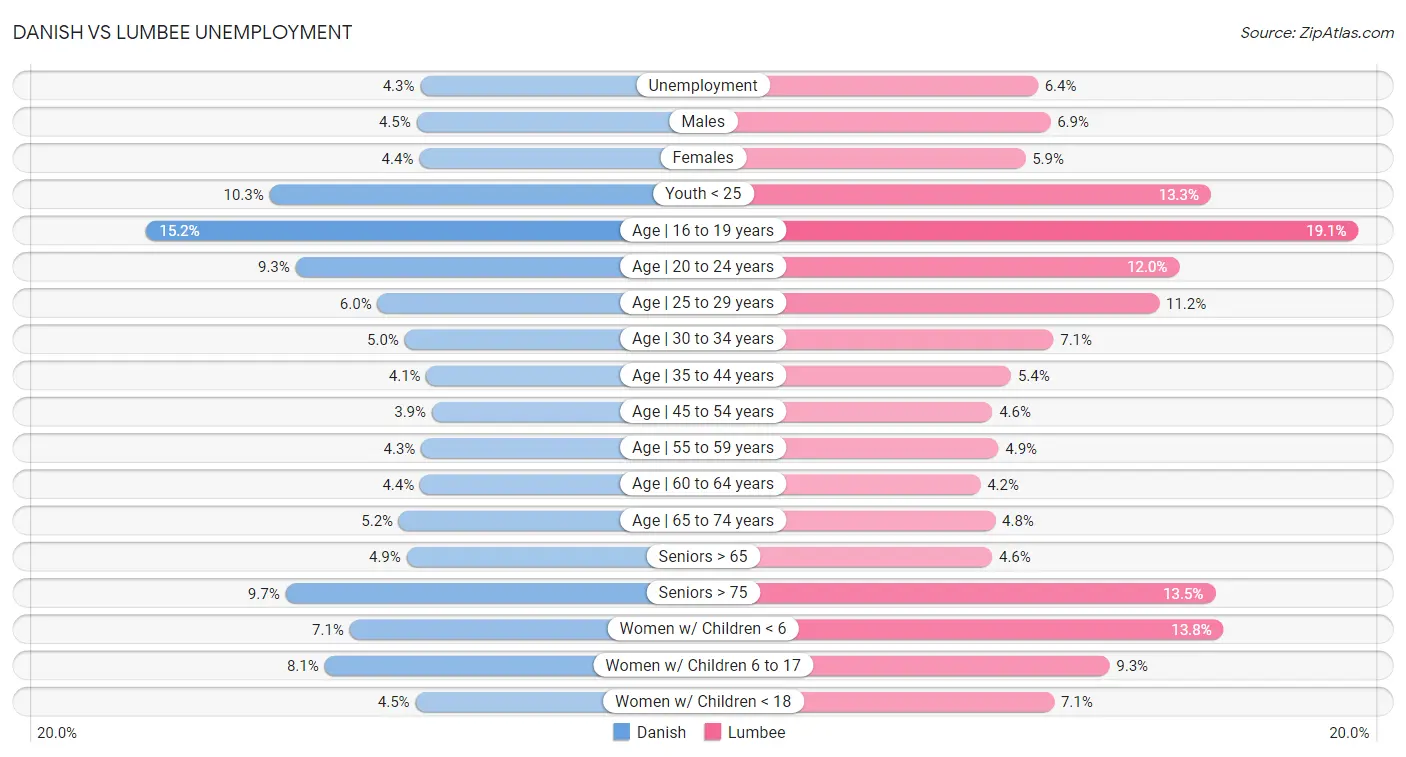
| Unemployment Metric | Danish | Lumbee |
| Unemployment | Exceptional 4.3% | Tragic 6.4% |
| Males | Exceptional 4.5% | Tragic 6.9% |
| Females | Exceptional 4.4% | Tragic 5.9% |
| Youth < 25 | Exceptional 10.3% | Tragic 13.3% |
| Age | 16 to 19 years | Exceptional 15.2% | Tragic 19.1% |
| Age | 20 to 24 years | Exceptional 9.3% | Tragic 12.0% |
| Age | 25 to 29 years | Exceptional 6.0% | Tragic 11.2% |
| Age | 30 to 34 years | Exceptional 5.0% | Tragic 7.1% |
| Age | 35 to 44 years | Exceptional 4.1% | Tragic 5.4% |
| Age | 45 to 54 years | Exceptional 3.9% | Tragic 4.6% |
| Age | 55 to 59 years | Exceptional 4.3% | Fair 4.9% |
| Age | 60 to 64 years | Exceptional 4.4% | Exceptional 4.2% |
| Age | 65 to 74 years | Exceptional 5.2% | Exceptional 4.8% |
| Seniors > 65 | Exceptional 4.9% | Exceptional 4.6% |
| Seniors > 75 | Tragic 9.7% | Tragic 13.5% |
| Women w/ Children < 6 | Exceptional 7.1% | Tragic 13.8% |
| Women w/ Children 6 to 17 | Exceptional 8.1% | Tragic 9.3% |
| Women w/ Children < 18 | Exceptional 4.5% | Tragic 7.1% |
Danish vs Lumbee Labor Participation
When considering labor participation, the most significant differences between Danish and Lumbee communities in the United States are seen in in labor force | age 16-19 (44.7% compared to 31.0%, a difference of 44.3%), in labor force | age 20-24 (79.0% compared to 65.5%, a difference of 20.6%), and in labor force | age > 16 (65.3% compared to 56.8%, a difference of 15.0%). Conversely, both communities are more comparable in terms of in labor force | age 25-29 (84.8% compared to 78.3%, a difference of 8.3%), in labor force | age 30-34 (84.3% compared to 77.3%, a difference of 9.0%), and in labor force | age 35-44 (84.3% compared to 77.0%, a difference of 9.5%).

| Labor Participation Metric | Danish | Lumbee |
| In Labor Force | Age > 16 | Good 65.3% | Tragic 56.8% |
| In Labor Force | Age 20-64 | Exceptional 79.9% | Tragic 70.6% |
| In Labor Force | Age 16-19 | Exceptional 44.7% | Tragic 31.0% |
| In Labor Force | Age 20-24 | Exceptional 79.0% | Tragic 65.5% |
| In Labor Force | Age 25-29 | Good 84.8% | Tragic 78.3% |
| In Labor Force | Age 30-34 | Tragic 84.3% | Tragic 77.3% |
| In Labor Force | Age 35-44 | Fair 84.3% | Tragic 77.0% |
| In Labor Force | Age 45-54 | Exceptional 83.3% | Tragic 75.6% |
Danish vs Lumbee Family Structure
When considering family structure, the most significant differences between Danish and Lumbee communities in the United States are seen in births to unmarried women (28.7% compared to 48.2%, a difference of 68.0%), single mother households (5.5% compared to 9.1%, a difference of 64.5%), and married-couple households (51.1% compared to 39.6%, a difference of 29.0%). Conversely, both communities are more comparable in terms of average family size (3.17 compared to 3.32, a difference of 4.6%), family households (66.0% compared to 63.1%, a difference of 4.7%), and divorced or separated (11.9% compared to 12.7%, a difference of 7.0%).

| Family Structure Metric | Danish | Lumbee |
| Family Households | Exceptional 66.0% | Tragic 63.1% |
| Family Households with Children | Exceptional 28.7% | Tragic 26.3% |
| Married-couple Households | Exceptional 51.1% | Tragic 39.6% |
| Average Family Size | Tragic 3.17 | Exceptional 3.32 |
| Single Father Households | Average 2.3% | Tragic 2.8% |
| Single Mother Households | Exceptional 5.5% | Tragic 9.1% |
| Currently Married | Exceptional 50.5% | Tragic 39.8% |
| Divorced or Separated | Excellent 11.9% | Tragic 12.7% |
| Births to Unmarried Women | Exceptional 28.7% | Tragic 48.2% |
Danish vs Lumbee Vehicle Availability
When considering vehicle availability, the most significant differences between Danish and Lumbee communities in the United States are seen in no vehicles in household (6.6% compared to 10.3%, a difference of 56.9%), 2 or more vehicles in household (63.3% compared to 55.9%, a difference of 13.3%), and 3 or more vehicles in household (24.7% compared to 23.1%, a difference of 6.8%). Conversely, both communities are more comparable in terms of 4 or more vehicles in household (8.6% compared to 8.8%, a difference of 2.5%), 1 or more vehicles in household (93.5% compared to 89.7%, a difference of 4.2%), and 3 or more vehicles in household (24.7% compared to 23.1%, a difference of 6.8%).

| Vehicle Availability Metric | Danish | Lumbee |
| No Vehicles Available | Exceptional 6.6% | Average 10.3% |
| 1+ Vehicles Available | Exceptional 93.5% | Average 89.7% |
| 2+ Vehicles Available | Exceptional 63.3% | Good 55.9% |
| 3+ Vehicles Available | Exceptional 24.7% | Exceptional 23.1% |
| 4+ Vehicles Available | Exceptional 8.6% | Exceptional 8.8% |
Danish vs Lumbee Education Level
When considering education level, the most significant differences between Danish and Lumbee communities in the United States are seen in professional degree (4.4% compared to 2.5%, a difference of 77.3%), doctorate degree (1.9% compared to 1.1%, a difference of 74.6%), and master's degree (14.5% compared to 9.3%, a difference of 57.0%). Conversely, both communities are more comparable in terms of nursery school (98.6% compared to 98.5%, a difference of 0.10%), kindergarten (98.6% compared to 98.5%, a difference of 0.13%), and 1st grade (98.6% compared to 98.5%, a difference of 0.13%).
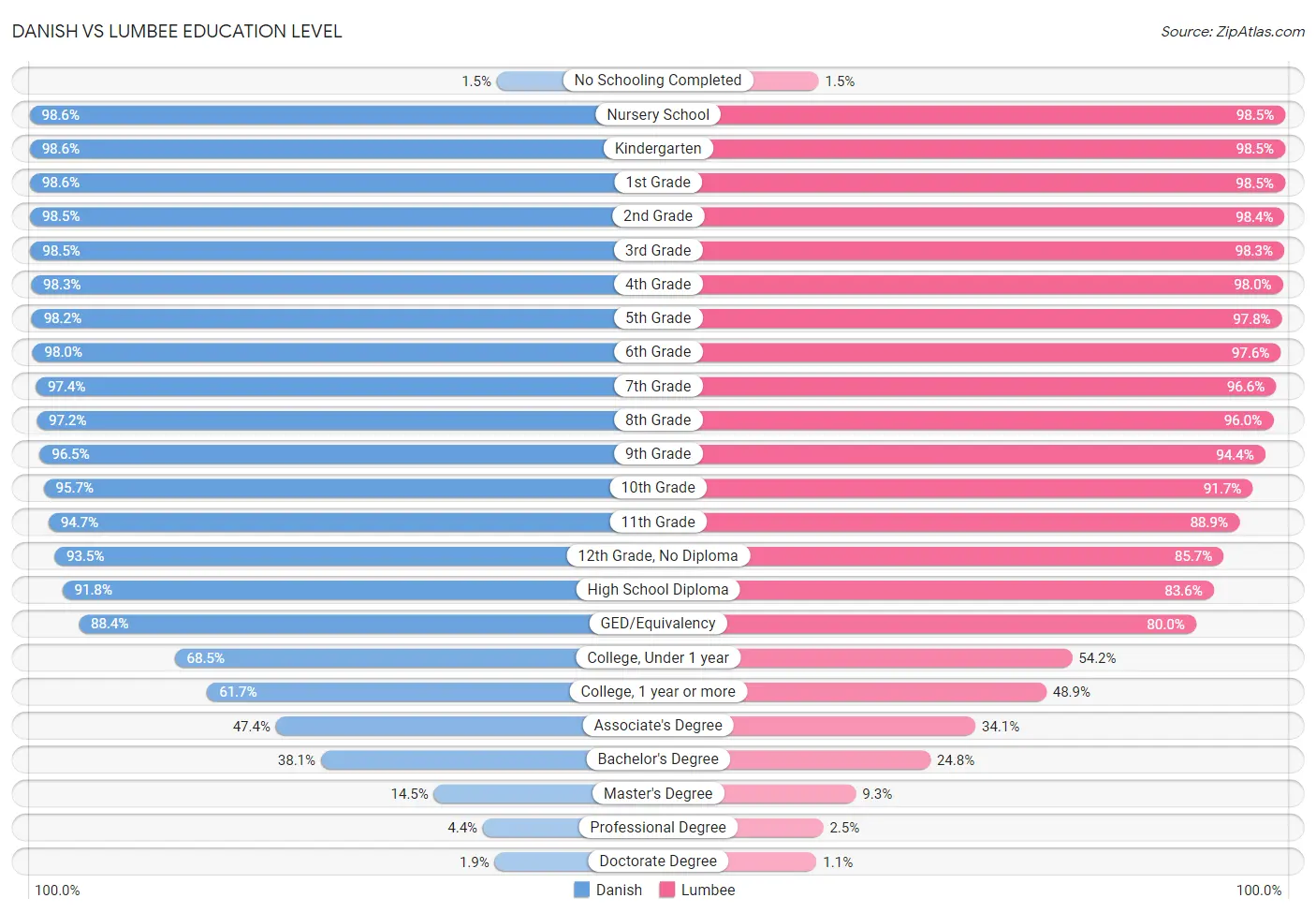
| Education Level Metric | Danish | Lumbee |
| No Schooling Completed | Exceptional 1.5% | Exceptional 1.5% |
| Nursery School | Exceptional 98.6% | Exceptional 98.5% |
| Kindergarten | Exceptional 98.6% | Exceptional 98.5% |
| 1st Grade | Exceptional 98.6% | Exceptional 98.5% |
| 2nd Grade | Exceptional 98.5% | Exceptional 98.4% |
| 3rd Grade | Exceptional 98.5% | Exceptional 98.3% |
| 4th Grade | Exceptional 98.3% | Exceptional 98.0% |
| 5th Grade | Exceptional 98.2% | Exceptional 97.8% |
| 6th Grade | Exceptional 98.0% | Exceptional 97.6% |
| 7th Grade | Exceptional 97.4% | Exceptional 96.6% |
| 8th Grade | Exceptional 97.2% | Excellent 96.0% |
| 9th Grade | Exceptional 96.5% | Tragic 94.4% |
| 10th Grade | Exceptional 95.7% | Tragic 91.7% |
| 11th Grade | Exceptional 94.7% | Tragic 88.9% |
| 12th Grade, No Diploma | Exceptional 93.5% | Tragic 85.7% |
| High School Diploma | Exceptional 91.8% | Tragic 83.6% |
| GED/Equivalency | Exceptional 88.4% | Tragic 80.0% |
| College, Under 1 year | Exceptional 68.5% | Tragic 54.2% |
| College, 1 year or more | Exceptional 61.7% | Tragic 48.9% |
| Associate's Degree | Good 47.4% | Tragic 34.1% |
| Bachelor's Degree | Average 38.1% | Tragic 24.8% |
| Master's Degree | Fair 14.5% | Tragic 9.3% |
| Professional Degree | Average 4.4% | Tragic 2.5% |
| Doctorate Degree | Good 1.9% | Tragic 1.1% |
Danish vs Lumbee Disability
When considering disability, the most significant differences between Danish and Lumbee communities in the United States are seen in vision disability (2.1% compared to 3.4%, a difference of 63.4%), ambulatory disability (5.8% compared to 9.5%, a difference of 63.1%), and disability age 35 to 64 (11.4% compared to 17.6%, a difference of 54.9%). Conversely, both communities are more comparable in terms of disability age 18 to 34 (7.5% compared to 7.4%, a difference of 0.84%), disability age under 5 (1.5% compared to 1.3%, a difference of 9.5%), and disability age 5 to 17 (5.7% compared to 6.2%, a difference of 10.2%).
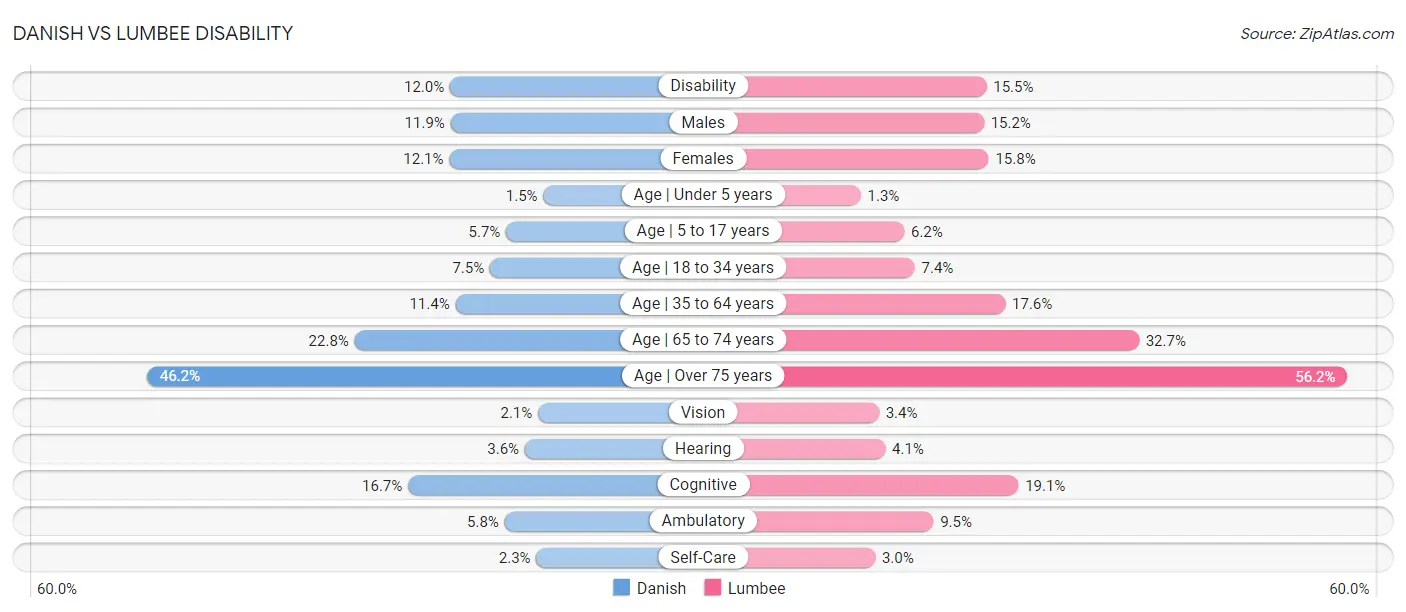
| Disability Metric | Danish | Lumbee |
| Disability | Tragic 12.0% | Tragic 15.5% |
| Males | Tragic 11.9% | Tragic 15.2% |
| Females | Good 12.1% | Tragic 15.8% |
| Age | Under 5 years | Tragic 1.5% | Tragic 1.3% |
| Age | 5 to 17 years | Fair 5.7% | Tragic 6.2% |
| Age | 18 to 34 years | Tragic 7.5% | Tragic 7.4% |
| Age | 35 to 64 years | Fair 11.4% | Tragic 17.6% |
| Age | 65 to 74 years | Excellent 22.8% | Tragic 32.7% |
| Age | Over 75 years | Exceptional 46.2% | Tragic 56.2% |
| Vision | Exceptional 2.1% | Tragic 3.4% |
| Hearing | Tragic 3.6% | Tragic 4.1% |
| Cognitive | Exceptional 16.7% | Tragic 19.1% |
| Ambulatory | Exceptional 5.8% | Tragic 9.5% |
| Self-Care | Exceptional 2.3% | Tragic 3.0% |